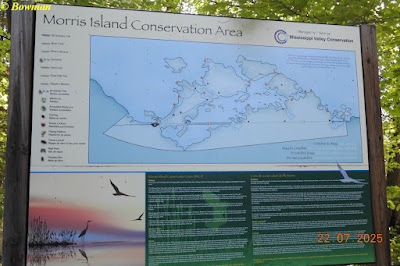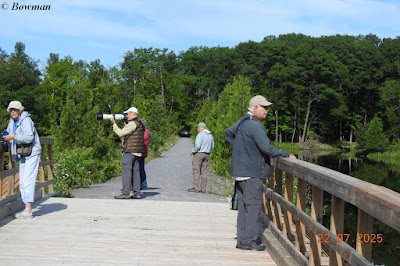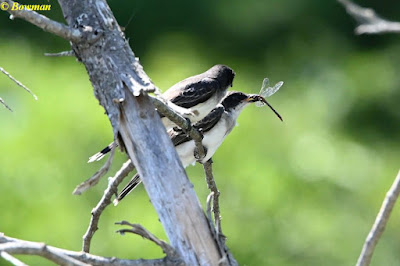July 22, 2025
Birding Report by Jane Burgess
We met up at
the Eagleson park & ride, Ken and Ian carpooled and off we went via
417. Our first stop was Holland Marsh. I received a phone call from
Ann asking about the turn off, I gave her the information and she joined
us maybe 5+ minutes later. There was very little water in the marsh but
still we saw a Great Blue Heron and four Mallards. On the other side
of the road we saw a far away bird — was it meadowlark or bobolink.
After some discussion and looking at Sibley's app we concluded it was a
female Bobolink. Females look totally different from males. Ken and
Bill saw a Northern Harrier. We stopped at the bridge to look at the
water— nothing.
Before we
got to Morris Island we stopped on a bridge. On a large rock in the
water were two large Water Snakes about 4 feet long. We all got out of
our respective cars to photograph them. Later Guy told me if the birding
day ended at that moment we would have gone home quite happy seeing
those snakes.
We got to
Morris Island, paid the entrance fee and off we went down the path. We
heard the ubiquitous Red-eyed Vireo — they never shut up!!! Next up
was an Eastern Wood Pewee high up almost at the top of the tree. An
Eastern Phoebe silently flew in. A little further down the trail we
saw an Eastern King Bird. We saw a Ruby-throated Hummingbird and a
Yellow- rumped Warbler. It was my first Ruby-throated Hummingbird of
the season.
While walking
we came upon Painted turtles sunning themselves. One of the turtle's
scutes was flaking off, this happens as it grows. Near this turtle was
another turtle that had an old injury probably caused by a Great Blue
Heron or a Common Raven. A bit further Guy pointed out a small little
turtle that turned out to be a Northern Map Turtle. There is a photo
of the two turtles together, check out the scutes on the shells — quite
different. I saw a shadow and looked up and said loudly "look up".
What I saw was a very pale belly, Ken saw a dark back. We agreed it was
a raptor and as a group we decided it was a Broadwinged Hawk.
We
walked a bit further then decided to turn around and take another
trail. Guy loves his plants and spotted a Broad - leaved Helleborine,
it is a member of the orchid family. Ann is into orchids and came to
check it out. Once she got home she called one of her friends and told
her. The 2 ladies are going back to see the plant on Thursday.
Walking
back very slowly I noticed something on the ground. It was an ant
moving some material so much bigger than itself. Of course I took a
photo. The ant species is called Silky Field Ant, it is a middle sized
ant that is fast moving. The worker ants are 4 to 8 mm long, black and
somewhat shiny.
As Ian and I watched, the ant left what he was carrying, then went back, grabbed it and then started to move quite quickly.
Once
back at the vehicles Guy pointed out the fruit of the Linden tree,
telling me you can make tea from them. Walking encyclopedia that Guy.
We decided it was snack time. Guy had brought some litchee and.
rambutan. I found the rambutan to be kind of bland but the litchee were
delicious and juicy.
We
left Morris Island and headed to the scenic bridges at Galetta. No
birds but it was very scenic. We headed to the McNamara Trail near
Almonte. Should we have lunch? Four of us had lunch while Ann and Guy
walked into the forest. They came back and told us there were so many
mosquitoes, the bugs particularly loved Guy. I asked him his blood
type. Response was ‘O’, yeah mosquitoes particularly like ‘O’ type
people and he said he was a universal donor particularly for mosquitos.
Funny guy. Ann and Guy left us, we told them where Peregrine Falcons
had been seen in Almonte.
We
sprayed ourselves with repellant which worked well for me. For me the
walk on the McNamara Trail was more of a nature walk than a birding walk
per se. I walked very slowly and first up was some Horse hoof fungi,
named because it resembles a horse's hoof. It's pretty common but it
can also affect horses' hooves, causing an infection like thrush. Down
the path I saw the coolest looking fungi -- white jelly fungi, it is
also called snow fungus or silver ear fungus. It is a gelatinous,
whitish mushroom that grows on decaying wood. IIt's edible and popular
in Asian cuisine. Fungus have always fascinated me.
Once
we got onto the Showy Lady Slipper boardwalk, I looked for the plant.
Of course the blooming of these plants are all done, but I wanted to see
if I could identify them, yep I could. Further down the boardwalk I
spotted Bottlebrush Sedge. Bill and Ken walked ahead of us, at one
point they called the rails, not response. Bill walked onto the bird
feeders, not filled hence no birds.
We
drove over to the church where the Peregrine Falcons were,'were' being
the operative word, long gone. Down near the river we saw no
waterfowl. We then drove to Clay Bank Nature Park. We checked out the
water, no water fowl. The trail was not obvious and I think the general
consensus was we had none enough walking for the day,
We
drove down Young Road and stopped at the water. There were two adult
Eastern Kingbirds feeding three rather noisy young. We watched for a
while hoping we would get a shot of the parent handing over, well
sticking their beaks down the young ones throat. Maybe the others were
successful..I took a photo and saw that one parent had a dragonfly in
its mouth but decided to eat it rather than feed its young.
The last stop was the Antrim Truck Stop for goodies. My husband always enjoys me birding near that bakery, it means I come home to feed his sweet tooth. When I got home I told him what I bought and asked if he wanted it now or later? Now and so we share a cinnamon bun -- can't say I was particularly hungry for dinner.
Driving
home I said to Bill, we did not see a Turkey Vulture nor Canada Geese.
Closer to Ottawa we saw a single Turkey Vulture. I also saw a
Red-tailed Hawk along the 417, something I don't see often on the 417..
In
the evening while Bill was working on his photos, he wrote me a note to
say Barbara had taken a photo of a Rose-breasted Grosbeak.
Today the birds were all very quiet today, they were there, but we had to see them with a sharp eye.
I
have included a short video taken by Ian of a Mayfly caught in a
spider's web. The video will be sent in email 2 of 3 and it might be
too large for some computers, so don't open the video.
I think this birding report is more like a nature report this time.
Species Notes
- American Goldfinch
- American Crow
- Song Sparrow
- Northern Cardinal
- Black-capped Chickadee
- Ring-billed Gull
- Great-blue Heron
- Swamp Sparrow
- Red-winged Blackbird
- Mallard
- Eastern Meadowlark
- Bobolink
- Northern Harrier
- Common Yellowthroat
- European Starling
- Tree Swallow
- Rock Pigeon
- Blue Jay
- Double-crested Cormorant
- Spotted Sandpiper
- Eastern Wood-Pewee
- Eastern Phoebe
- Eastern Kingbird
- Red-eyed Vireo
- Ruby-throated Hummingbird
- Cedar Waxwing
- Broadwing Hawk
- Yellow-rump Warbler
- Great-crested Flycatcher
- White-breasted Nuthatch
- Mourning Dove
- Northern Waterthrush
- Chestnut-sided Warbler
- Common Grackle
- Red-shouldered Hawk
- Barn Swallow
- Yellow-bellied Sapsucker
- Turkey Vulture
- Red-tailed Hawk
- Rose-breasted Grosbeak
Critters Noted
- American Bullfrog
- Green Frog
- Water Snake
- Groundhog
- Painted Turtle
- Northern Map Turtle
- Muskrat





































No comments:
Post a Comment